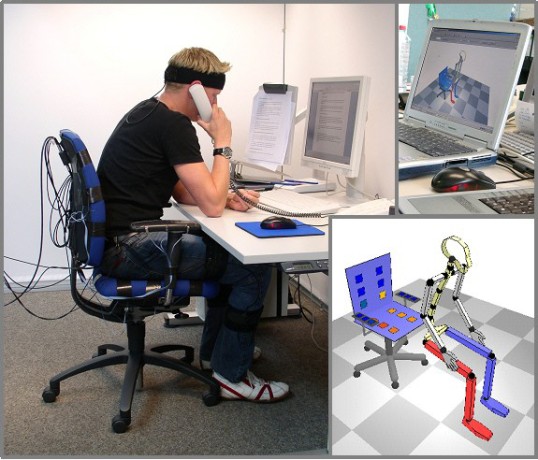- Elektromagnetic Fields
- Indoor workplaces
- Practical Solutions: Ergonomics
- Practical solutions: Hazardous substances
- Practical solutions: Noise
- Practical solutions: Machine safety
- Practical solutions: Personal Protective Equipment
Workplace design

Measurement at a simulated office workplace in a laboratory environment; display in the CUELA software environment
Source: IFA
It is essential that indoor workplaces correspond with the needs and attributes of the people who work in them. Many workers at such workplaces nevertheless complain of musculoskeletal disorders, particularly in the upper limbs (neck, shoulder, arms and hands, back). Tasks repeated continually and frequently, static or unfavourable body postures, a lack of breaks, and also a lack of movement are among the known possible causes of these complaints.
The following recommendations are intended to help reduce musculoskeletal strain:
- the strain caused by poor or uneven posture (e.g. twisted posture or prolonged periods in a seated position) or repetitive movements (e.g. prolonged use of a keyboard) should be reduced by shortening the period spent on such activities. This can be done by combining different tasks, giving the employee additional tasks or ensuring sufficient breaks;
- favourable posture and changes in posture should be promoted by ensuring individually adjustable and ergonomic workstations.
Research projects
IFA4202 "Ergonomic study of office workplaces involving multiple display screens or large screens"
For download

Further information

- Ergonomics – Technical information of the IFA
- Occupational musculoskeletal diseases of the upper extremities - Technical information of the IFA
- Ergonomic requirements for computer input devices - Technical information of the IFA
- Ergonomic studies during seated tasks - Technical information of the IFA
- ErgoKita: Ergonomic design of workplaces in children's daycare facilities - Technical information of the IFA
- Laboratory study of the efficacy of dynamic office workstations. (PDF, 131 kB, non-accessible) Focus on IFA's work 0379
- Ergonomics at call-centre workplaces. (PDF, 112 kB, non-accessible) Focus on IFA's work 0178
- Physical stress profiles at checkout workplaces (PDF, 119 kB, non-accessible) Focus on IFA's work 0321